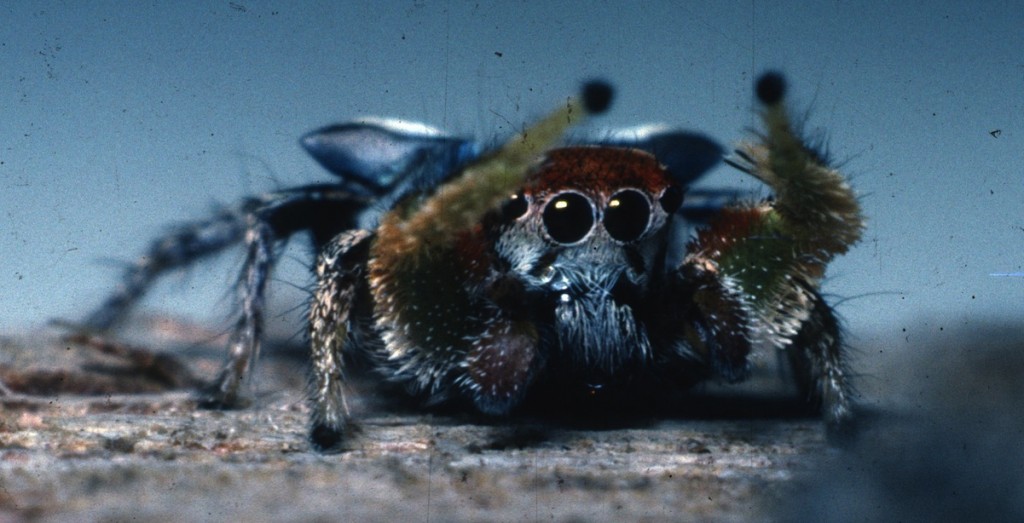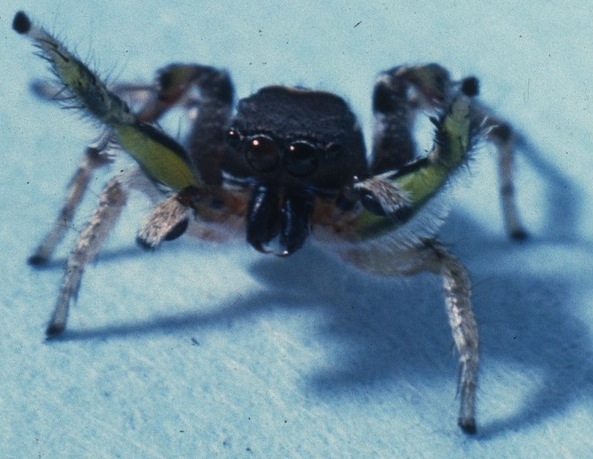 When it comes to complex courtship displays, birds of paradise are right up there. They do this whole hanging-upside-down-from-a-branch thing. And granted, the mantis shrimp has an impressive suite of wooing manoeuvres, used to communicate amorous intentions to the potential mate in question (otherwise the wooer might come across as an aggressor to the wooee). But complexity for size, the jumping spider (family Salticidae) has got to take the cake.
When it comes to complex courtship displays, birds of paradise are right up there. They do this whole hanging-upside-down-from-a-branch thing. And granted, the mantis shrimp has an impressive suite of wooing manoeuvres, used to communicate amorous intentions to the potential mate in question (otherwise the wooer might come across as an aggressor to the wooee). But complexity for size, the jumping spider (family Salticidae) has got to take the cake.
“The first time I would have seen a habernatus dance would have been in 1974,” says Wayne Maddison, zoologist and Director of the Beaty Biodiversity Museum at the University of British Columbia in Vancouver, Canada. He recalls that as he watched, transfixed, the male spider’s dance just kept going and going. “It was this thought of: Oh my god is this complexity ever going to end?”
 Apparently not. Thirty-seven years later and Maddison is still studying the courtship dances of jumping spiders. Most recently Maddison and his colleague Damian Elias at the University of California, Berkeley, have filmed hi-def videos of the courtship displays to analyze them, sort of like reverse choreography.
Apparently not. Thirty-seven years later and Maddison is still studying the courtship dances of jumping spiders. Most recently Maddison and his colleague Damian Elias at the University of California, Berkeley, have filmed hi-def videos of the courtship displays to analyze them, sort of like reverse choreography.
Maddison plays one of the videos from his office computer for me. And the five millimetre male spider is off! There are loud snaps. Waving legs. Other waving legs. To and fro-ing. Thrumming. Wiggles. Waggles. His palps rotate in circles (whirrr). He walks on four legs, the other four raised.
All in all, the scientists have identified seven distinct stages (but then there are substages within each stage) to the display. “It’s almost like a medley of seven tunes,” describes Maddison. So basically the male spider’s courtship display is like a highlight reel of an entire episode of Glee, and a long one at that. Some Salticidae courtship displays last up to 20 minutes. As Maddison points out: “that’s a significant portion of their life span compared to us.”
Jumping spider would appear to be a bit of a misnomer then. Dancing spider or Ziegfield folly spider would be more apropos. So how did this behaviour evolve? They say that behind every man is a woman. In the case of jumping spiders, in front of every jigging male is a female, a largely uninterested one at that. “So the female wants to say no but he puts it in big bright letters “new and improved”,’ explains Maddison. “He’s basically finding loopholes in her sensory system.” So as the male spider escalates his song and dance, the female escalates her threshold for rejecting him, thereby fueling a sort of advertising race between jaded consumer and desperate salesman.
The process is called antagonistic co-evolution, and is considered to be one of the driving evolutionary forces behind the arms race between parasites and their hosts. The idea is that as soon as, say, the host evolves a defense mechanism to thwart a parasite, the parasite in turn evolves another way to infect the host, which the host then evolves to thwart and so the arms race continues in perpetuity. In which case, the male spider’s bells and whistles aren’t so much amorous as they are armament. So when Maddison muttered to himself upon seeing his first jumping spider dance “Oh my god is this complexity ever going to end?” he unwittingly summed up the entire process. Who knows how much more complex the male jumping spider’s dance routine will evolve over time – or how blasé the female will become to the ever-complex song and dance?
Now, if you find yourself enamoured with the jumping spider – unlike said blasé female spider – Maddison’s recently discovered a new species of jumping spider in Ecuador last year. It needs a name. Oblige him by visiting the Beaty Museum contest page here!
_______
Anne Casselman is a Vancouver-based science writer. She writes for various outlets including Canadian Geographic, ScientificAmerican.com, National Geographic News and The Walrus (on the topic of dancing, but not in an evolutionary light).
Photo credits: Wayne Maddison
Come on! Where’s the video! You got me all worked up to see this courtship dance, and no video link?
I want to see wiggles, waggles, and (most especially) to and fro-ing!
Zachary, The Awl beat us to it. And then some: it added videos of similar human dances of love.
http://www.theawl.com/2011/07/watch-a-jumping-spider-dance-to-impress-a-prospective-mate-and-name-a-newly-discovered-species
thanks, anne. what a great site! so clever to link those videos with the spider dance. my vote — david lee roth IS the spider-man.
He had my vote too, same gestures, everything.
Jumping spiders are always very photogenic. Thanks so much for a great arachnid post!
Thanks for all the dancing spider love people!
A passing thought: what maketh you of a dancing spider interpretive dance contest…?
It actually reminds me a bit of this spider:
http://www.youtube.com/watch?v=CygZOGNs3PY
These 8 legged arthropods freak me out though I will say. I don’t like them one bit.
I can see how people would think the dancing ones are cute. Either way, I don’t want them crawling on my face in the middle of the night that’s for sure!
Vince Delmonte
This got me to thinking. It really does show challenge for the male spiders. I really wanted to watch how they do this.
Why do these jumping spiders have to be all hairy? I think it’s just the hair on those things that freaks me out.
I went to the spider contest page:
http://www.beatymuseum.ubc.ca/spider-contest
But the contest is now closed. 🙁
– Linda
Austin, Texas
“When it comes to complex courtship displays”, I guess love spiders have all the moves. Maybe the males should audition for ‘Dancing With The Stars’.
Holly Hayden
Provo, Utah